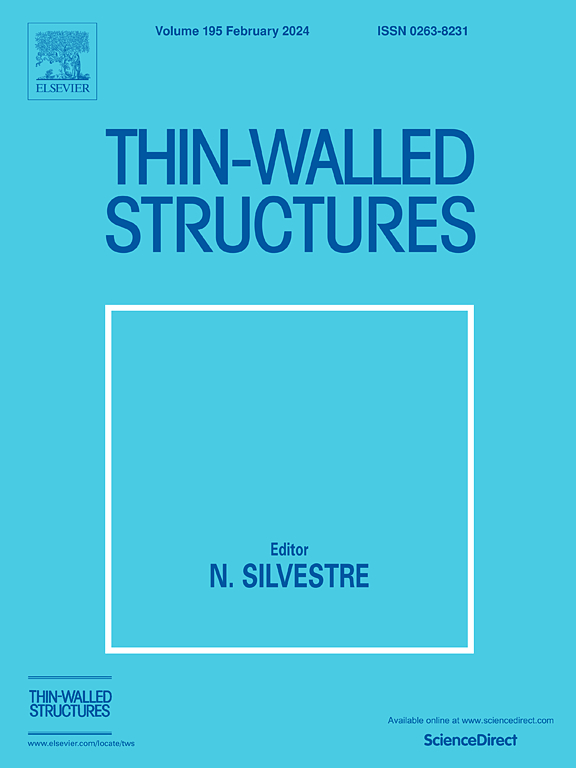Bearing and tearout of austenitic and duplex stainless steel bolted connections
IF 6.6
1区 工程技术
Q1 ENGINEERING, CIVIL
引用次数: 0
Abstract
Due to the unique material characteristics of stainless steel, the bearing and tearout behaviour of stainless steel bolted connections can be different from that of carbon steel bolted connections. Such difference has been gradually recognised in recent design provisions for stainless steel structures. However, it is noteworthy that the existing design methods were mainly developed for austenitic and ferritic stainless steel bolted connections. Their applicability to duplex stainless steel bolted connections is questionable. Moreover, comparing to the bearing failure of stainless steel connections, less attention has been paid to the tearout failure, as well as the combined bearing and tearout failure in multi-bolt connections. To fill these gaps, an experimental and numerical study is carried out on the bearing/tearout behaviour and design of stainless steel bolted connections. The experimental programme includes 22 connection specimens with either single-bolt or multi-bolt configurations, made of austenitic or duplex stainless steel. The experimental tests are supplemented by a comprehensive numerical parametric study with >200 individual models, performed based on a validated finite element modelling technique. The obtained test and numerical results are used to assess the effects of different design parameters, as well as the applicability of existing design methods. It is concluded that the ultimate bearing/tearout resistances of austenitic and duplex connections are not simply proportionate to the ultimate strengths of the two materials. Given the same geometric design, the bearing resistance of a duplex connection is considerably higher than that of an austenitic connection, despite the similar ultimate strengths of the two materials. This difference in bearing performance is attributed to the different strain-hardening characteristics of austenitic and duplex materials, as well as the premature shear cracking in austenitic connections that leads to insufficiently developed strain-hardening. In comparison, the tearout resistances of austenitic and duplex connections with the same geometry are much closer, since the smaller end distance leads to more uniform deformations and more completely developed strain-hardening. Moreover, the combined bearing and tearout resistance of multi-bolt connections is found to be lower than the sum of the respective resistances of individual bolts. Finally, an updated design method is proposed that can accurately predict the bearing/tearout resistance of both austenitic and duplex stainless steel bolted connections. Proper partial factors are determined for the proposed method based on a reliability analysis.
奥氏体和双相不锈钢螺栓连接的承载和撕裂
由于不锈钢独特的材料特性,不锈钢螺栓连接的承载和抗撕裂性能可能不同于碳钢螺栓连接。最近的不锈钢结构设计规定已逐渐认识到这种差异。但值得注意的是,现有的设计方法主要是针对奥氏体和铁素体不锈钢螺栓连接而开发的。它们对双相不锈钢螺栓连接的适用性值得怀疑。此外,与不锈钢连接的轴承失效相比,人们对多螺栓连接中的撕裂失效以及轴承和撕裂的综合失效关注较少。为了填补这些空白,我们对不锈钢螺栓连接的承载/撕裂行为和设计进行了实验和数值研究。实验项目包括 22 个由奥氏体或双相不锈钢制成的单螺栓或多螺栓结构连接试样。在实验测试的基础上,还利用经过验证的有限元建模技术对 200 个单独模型进行了全面的数值参数研究。获得的试验和数值结果用于评估不同设计参数的影响以及现有设计方法的适用性。得出的结论是,奥氏体连接和双相连接的极限承载/抗撕裂性能并不简单地与两种材料的极限强度成比例。在几何设计相同的情况下,尽管两种材料的极限强度相似,但双相连接的承载阻力大大高于奥氏体连接。这种承载性能上的差异归因于奥氏体材料和双相材料不同的应变硬化特性,以及奥氏体连接中过早的剪切开裂导致应变硬化发展不充分。相比之下,具有相同几何形状的奥氏体和双相材料连接的抗撕裂性能要接近得多,因为较小的端距会导致更均匀的变形和更完全的应变硬化。此外,还发现多螺栓连接的综合承载和抗撕裂能力低于单个螺栓各自的抗力之和。最后,提出了一种最新的设计方法,可以准确预测奥氏体和双相不锈钢螺栓连接的承载/抗撕裂性能。在可靠性分析的基础上,为拟议方法确定了适当的局部系数。
本文章由计算机程序翻译,如有差异,请以英文原文为准。
求助全文
约1分钟内获得全文
求助全文
来源期刊

Thin-Walled Structures
工程技术-工程:土木
CiteScore
9.60
自引率
20.30%
发文量
801
审稿时长
66 days
期刊介绍:
Thin-walled structures comprises an important and growing proportion of engineering construction with areas of application becoming increasingly diverse, ranging from aircraft, bridges, ships and oil rigs to storage vessels, industrial buildings and warehouses.
Many factors, including cost and weight economy, new materials and processes and the growth of powerful methods of analysis have contributed to this growth, and led to the need for a journal which concentrates specifically on structures in which problems arise due to the thinness of the walls. This field includes cold– formed sections, plate and shell structures, reinforced plastics structures and aluminium structures, and is of importance in many branches of engineering.
The primary criterion for consideration of papers in Thin–Walled Structures is that they must be concerned with thin–walled structures or the basic problems inherent in thin–walled structures. Provided this criterion is satisfied no restriction is placed on the type of construction, material or field of application. Papers on theory, experiment, design, etc., are published and it is expected that many papers will contain aspects of all three.
 求助内容:
求助内容: 应助结果提醒方式:
应助结果提醒方式:


